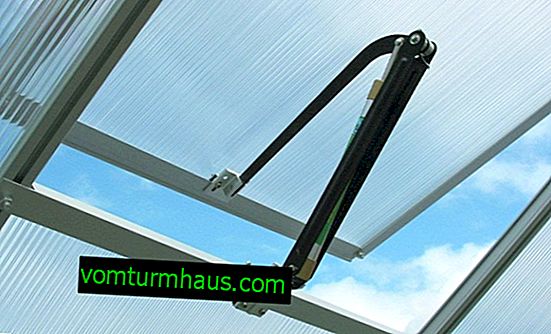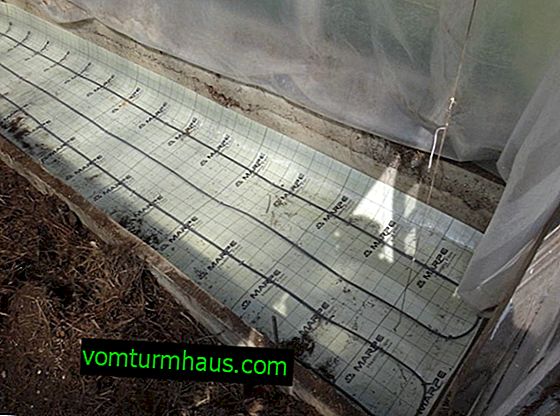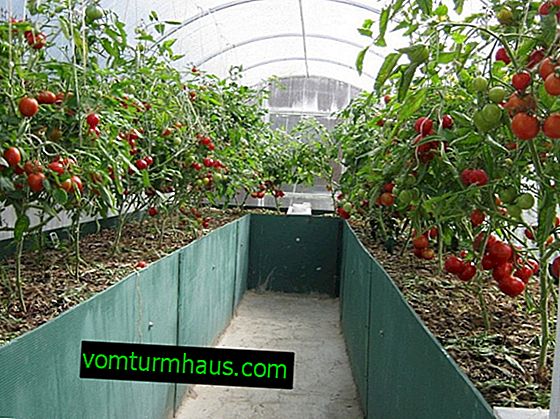How to remove condensate in a greenhouse?
Many gardeners are faced with the problem of condensation in a polycarbonate greenhouse. This problem must be solved without delay, because excessive humidity can lead to the multiplication of pests, diseases, and sometimes loss of crop. From the article you will learn why condensation occurs, and how to get rid of it.
Causes of condensation in the greenhouse
Condensation is formed for a natural reason - moisture from plant fumes accumulates indoors. The presence of condensation is easy to check - these are drops of water under the ceiling and on the walls of the room. By itself, this moisture does not pose a threat to plants, but it can provoke the development of diseases, as well as the appearance of insects.

Factors that contribute to the increase in the amount of condensate:
- Lack of ventilation . In case of disturbed and inconsistent ventilation, moisture will accumulate in the greenhouse. Often condensation occurs where there are no windows and windows, and ventilation is carried out only through the doorway, which is not enough for proper air circulation. In addition, airing through the door can harm the plants, because fresh air will go down.
- High density landing . Close-planted plants and irregular removal of fallen leaves and side shoots also lead to increased humidity. The recommended norm for planting is 2 plants per 1 m².
- Wrong watering . A common mistake is evening watering. You need to water the plants before noon, so the evaporation will have time to air out during the day. With evening watering, most will settle at night on the walls of the room. Be sure to irrigate with warm water.
Important! Some plants are more sensitive to moisture than others. For example, tomatoes do not like wet leaves, but cucumbers are less picky.
Unreasonable landing
Owners of a small summer cottage often can not afford to build 2-3 greenhouses, so they plant plants too crowded. The advice of experienced gardeners is not to save on space, so as not to reduce the efficiency of fruiting seedlings and not to increase the accumulation of water in the air. More than 3 plants per 1 m² should not be placed.

| Plant | The distance between the rows, cm | The distance between plants, cm |
| A tomato | fifty | 25–40 |
| Cucumber | 40 | twenty |
| Pepper | fifty | 20–25 |
| Watermelon | fifty | 70 |
These data may vary depending on the variety of plants grown.
Temperature difference
Another common cause of condensation is the difference in temperature between the room and the environment. The function of the greenhouse itself is that it collects the incoming thermal radiation from the outside and stores it. This allows you to create a stable climate inside, favorable for the development of plants. Condensation occurs when the temperature inside the room exceeds the temperature outside.
Read also articles on this topic:






The necessary level of heat inside the greenhouse depends, first of all, on the plants that will be grown there. However, there is an optimal level, which is +16 ... + 25 ° С during the day and -4 ...- 8 ° С at night. Fruits develop more actively if a gradual increase in temperature is carried out. But + 40 ° C is the limit, then the plant will die. It is also important to monitor the temperature of the soil. It warms up much slower than air, but it is able to accumulate and give off heat. The optimum temperature is +14 ... + 25 ° С.
From internal overheating will help:
- good ventilation (window leaves for the night can not be closed);
- use of an automatic regulator;
- throwing branches and shadow nets on the greenhouse;
- planting shrubs around the greenhouse;
- to ensure that the greenhouse during the day is no more than 4 hours under the open rays of the sun.

High humidity
Humidity is one of the components of the microclimate in the greenhouse. It is not easy to monitor and control. The presence of condensation clearly indicates increased humidity. This is fraught with consequences such as:
- outbreaks of disease;
- the appearance of mold and fungi;
- guttation (fluid excretion by plant leaves).
Ways to reduce moisture include:
- soil mulching (coating with organic materials or cardboard, agrofibre);
- covering the soil with a film;
- improvement of the ventilation system.
Important! If you notice white stains on the leaves - these may be water spots, which indicate a saturation with moisture by the plant.
It is necessary to calculate areas with an uneven distribution of heat (containers with water, plants with large fleshy leaves, metal structures) - due to the fact that the temperature of their surface is lower, steam condenses easily on them and dew falls.
Watering plants in the evening is a gross mistake. You need to water them before lunch, moisture will accumulate much more slowly. A polycarbonate greenhouse will not have time to ventilate if watering is carried out in the evening. In addition, by the end of summer it is better to reduce the number of irrigation - plants no longer need such an amount of water.

There are two types of watering in a greenhouse:
- Manual It implies that the gardener at a certain time will collect water in the tank, and water the plants with it. This option is good in that a failure in such a system should not occur, here everything depends only on the gardener.
- Automatic The system irrigates independently. All that is needed is to set the correct dosage of water.
When using any of them, the use of water with impurities of volatile mixtures should be avoided. Well, if you can use your own underground wells and wells. If this is not possible, then tap water should be allowed to stand for a couple of days.
Read also how to make automatic drip irrigation from a barrel.
Greenhouse condensate control methods
Almost all gardeners growing plants in a greenhouse encounter condensation. There are proven ways to deal with it.
Ventilation
Ventilation is one of the most important points in growing plants in a polycarbonate greenhouse. Constant air circulation is necessary for the implementation of photosynthesis by plants and the maintenance of a favorable microclimate inside.

All ventilation systems can be divided into two types:
- mechanical (window leaves and doors open and close manually);
- automatic (use of special fans and designs).
The first type does not require costs and additional waste of time for installation of equipment, however, mechanical systems are so good that they can independently control and maintain the temperature inside the greenhouse. Did you know? Cellular polycarbonate invented in Israel specifically for greenhouses. The first sheet was released in 1976. There are such automatic ventilation systems for greenhouses:
- Electric . For manufacturing, only a thermal relay (temperature controller, thermostat) and a fan are needed. This design is easy to build independently. When the temperature inside exceeds the set norm, the relay sends a signal to the fan, and the ventilation system is activated. Plus in the absence of constant drafts. The downside is high energy consumption.

- Hydraulic It consists of sensors, special levers, a piston, a cylinder with heat-sensitive liquid or a can, all connected to the transom (the upper leaf of a window or door). The mechanism comes into action by expanding the fluid inside the device with increasing air temperature and closes or opens the window.

- Bimetallic . It contains two plates, which, under the influence of heat, bend and move the window, closing or opening it. Affordable and efficient design.

In hot seasons, a longer and more thorough ventilation is necessary. The temperature inside the structure can quickly heat up, which will lead to undesirable consequences. In winter, it would seem that ventilation is not so necessary, because then it will be impossible to maintain the inside temperature at the same level. In fact, in winter, airing is just as necessary as in other seasons. Air should not stagnate. In this case, it is necessary to maintain a balance between ventilation and warming.
Greenhouse insulation
Polycarbonate is one of the most suitable materials for greenhouses, it is able to contain the cold. But in winter this will not be enough, additional insulation is needed.
Read more about how to insulate a greenhouse for the winter with your own hands.
This can be dealt with both with the help of professionals, and independently. Before proceeding with warming, it is necessary to treat all cracks and small holes with heat-insulating compounds. In cold seasons, the greenhouse experiences high atmospheric loads, so it is better to use a two-component polysulfide composition as a sealant.
Methods of warming a polycarbonate greenhouse:
- Tightening with plastic wrap . The room is covered with a film inside so that there is a distance between the main covering material and polyethylene. This whole airspace contains the whole point - still air does not conduct heat well. It is important that the outer coating is completely tight.

- Foundation . Building a foundation can be a costly and time-consuming method, but it will not only help to keep warm, but also protect from rodents. Freezing depth of 50 cm is sufficient to protect against cold. Concrete, brick, timber can be used as materials.

- High beds in the greenhouse . Plants will not freeze if the beds are raised to 40 cm, and the soil below is insulated with compost.

- Ground insulation . Another effective way to keep plants warm is to lay a special insulation instead of compost under the ground. It will be an insulator and will not allow heat to leave.

For greater efficiency, you can use several methods of insulation at once. Also, do not forget to remove the snow around the structure.
Important! Snow can be used as a moisturizer for the soil.
Heating
One of the effective ways to eliminate condensate is heating. It is especially necessary for plants in winter. For normal growth, the temperature should be above + 18 ° C. With the help of wall insulation alone, this effect cannot be achieved.
Electric heating. This is an effective method for small greenhouses with good insulation. Special heating systems can be configured to deliver heat in various doses. For electric heating, you can choose one of the following methods:
- electrical cable;
- heating mats;
- convection units;
- heat pumps;
- infrared heaters.

When using any of the methods, it is important not to make a mistake with the temperature, otherwise it will lead to overheating of the root system of the plant. Did you know? In Iceland, greenhouses are built directly on geysers. So, if you see a greenhouse there, be sure - there is a pool with hot water nearby.
Air heating. Pretty primitive way, but still popular. The system consists of laying a pipe around the perimeter of the greenhouse, with one end facing out. A fire is set under it, and hot air will spread through the greenhouse. This method is not suitable for maintaining a stable temperature, but can save in case of unexpected frosts.

Biological heating. This method uses organic substances that produce heat during decomposition. The advantage of the method is that during decomposition, additional carbon dioxide is released, which plants need. Gardeners often use horse manure.

Solar heating . If the region is warm, where the sun can supply plants with heat all year round, then you can get by with natural solar heating. Polycarbonate is a transparent material that transmits rays, they, in turn, heat the plants. For this method, the greenhouse needs to be in a sunlit area. The disadvantage of this method is that such a system is unstable. In cloudy weather, heating will not be carried out.

Water heating . Suitable for large greenhouses, and everyone can implement this method. It uses a heated liquid that carries heat throughout the room. The circulation occurs either due to the slope, or thanks to special pumps.

Ventilation, heating, insulation, proper seating and care are the main steps to eliminate condensation in the greenhouse. So that your greenhouse does not “sweat”, you need to follow simple rules and use these tips. Good luck










